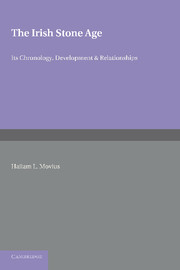Book contents
- Frontmatter
- Dedication
- Contents
- ILLUSTRATIONS
- FOREWORD
- PREFACE
- INTRODUCTION
- Part One THE CHRONOLOGY OF THE LATE-GLACIAL AND EARLY POST-GLACIAL PERIODS IN NORTHERN AND WESTERN EUROPE
- Part Two THE STONE AGE CULTURES OF IRELAND
- CHAPTER I The Antiquity of Man in Ireland
- CHAPTER II The Mesolithic Culture of the Irish Raised Beaches
- CHAPTER III The Origin and Affinities of the Larnian Culture
- CHAPTER IV Post-Larnian Developments
- CHAPTER V Conclusions
- Appendices I-VI
- REFERENCES CITED IN THE TEXT
- CLASSIFIED LIST OF REFERENCES TO CAVE RESEARCH AND STONE AGE ARCHAEOLOGY IN IRELAND
- ADDENDUM
- INDEX
CHAPTER II - The Mesolithic Culture of the Irish Raised Beaches
from Part Two - THE STONE AGE CULTURES OF IRELAND
Published online by Cambridge University Press: 05 June 2016
- Frontmatter
- Dedication
- Contents
- ILLUSTRATIONS
- FOREWORD
- PREFACE
- INTRODUCTION
- Part One THE CHRONOLOGY OF THE LATE-GLACIAL AND EARLY POST-GLACIAL PERIODS IN NORTHERN AND WESTERN EUROPE
- Part Two THE STONE AGE CULTURES OF IRELAND
- CHAPTER I The Antiquity of Man in Ireland
- CHAPTER II The Mesolithic Culture of the Irish Raised Beaches
- CHAPTER III The Origin and Affinities of the Larnian Culture
- CHAPTER IV Post-Larnian Developments
- CHAPTER V Conclusions
- Appendices I-VI
- REFERENCES CITED IN THE TEXT
- CLASSIFIED LIST OF REFERENCES TO CAVE RESEARCH AND STONE AGE ARCHAEOLOGY IN IRELAND
- ADDENDUM
- INDEX
Summary
DISTRIBUTION AND METHOD OF APPROACH
The sites of this period occur in abundance along the coast of North-East Ireland, from Carlingford Lough around to the mouth of the Lower Bann River, and in all cases they are associated with Post-Glacial marine deposits. Prior to 1930 only one of these, Curran Point, Larne, County Antrim, had been scientifically excavated (Praeger, 1890; Gray, W., 1890; Coffey and Praeger, 1904). Therefore, the problem of the Harvard Archaeological Expedition was to select key stations where the archaeological sequence could be established, since in spite of the wealth of material in the Dublin and Belfast Museums, the origin and development of the Irish Stone Age had never been completely worked out. In selecting the four sites which were excavated in 1934—6, the expedition was given much helpful advice by Mr C. Blake Whelan, M.R.I.A., of Belfast, who together with Mr J. P. T. Burchell, F.S.A., of London, has been untiring in his efforts to further the cause of Irish prehistory in recent years. During the last century Dr Praeger (1892, 1896) established the Post-Glacial stratigraphy of Northern Ireland, based on a detailed geological study of the coastal deposits with special reference to the fauna which they contained. But the archaeological sequence has never been fitted into this succession, nor have the beds been thoroughly investigated from a palaeobotanical point of view. In this regard the expedition worked in conjunction with the Committee for Quaternary Research in Ireland, and Professor K. Jessen was able to examine each site where polleniferous deposits were uncovered. At two of the localities, Cushendun and Glenarm, County Antrim, the recent physiographic history of the region as a whole was studied by F. L. W. Richardson, Jr., of Harvard, and the important work of identifying the marine fauna was undertaken throughout by Mrs N. F. McMillan of Liverpool. The conclusions of each of these specialists is contained in the discussion of the excavations in the first part of this chapter. Before considering this information, however, the composite section, as originally produced by Praeger (1892, p. 213; 1896, p. 43), will be presented. This provides the basis of the archaeological sequence, and the evidence has been confirmed by excavation and pollen analysis.
- Type
- Chapter
- Information
- The Irish Stone AgeIts Chronology, Development and Relationships, pp. 121 - 174Publisher: Cambridge University PressPrint publication year: 2013



